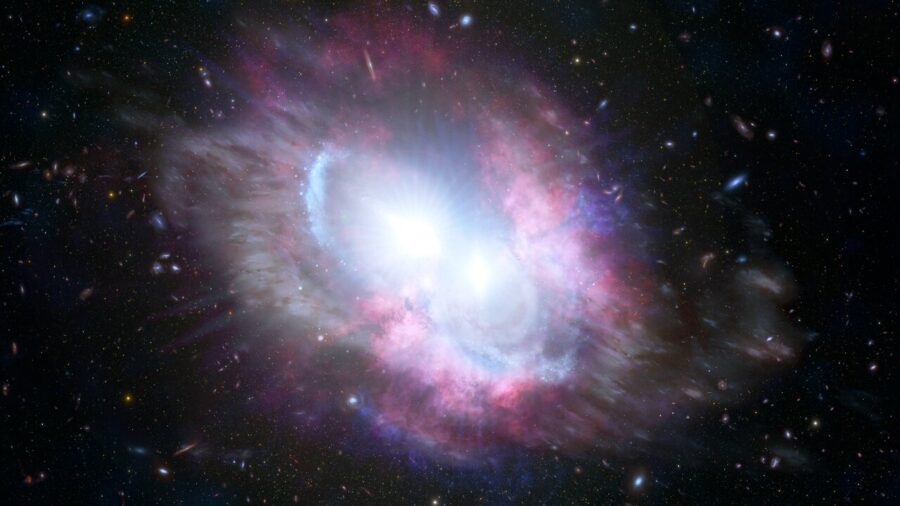The most distant pair of supermassive black holes discovered offers a unique insight into how galaxies merge.

International Gemini Observatory / NOIRLab / NSF / AURA / M. Zamani, J. da Silva
When two galaxies collide, the event wreaks havoc in the galactic landscape, triggering bursts of star formation, affecting the flow of gas, and in the center of the merged galaxy, resulting in the merger of the galaxies’ supermassive black holes.
Astronomers want to understand how black holes spiral toward each other, because these mergers impact the evolution of their host galaxies. But while we’ve found numerous pairs of black holes nearby, more distant counterparts have been elusive until now.
Publishing in Nature, Yu-Ching Chen (University of Illinois, Urbana-Champaign) and colleagues announced the discovery of the most distant supermassive black hole pair, seen at a time when the universe was only 3 billion years old. The finding sheds light on galaxy evolution during a lively period called cosmic noon, when galaxies were growing and forming stars at an exceptional rate.
Hiding in the Distance
Supermassive black holes don't emit light unless gas flows in, heating up and shining across the electromagnetic spectrum. A merger can feed a black hole and turn it into an active galactic nucleus (AGN), a bright beacon visible across vast distances. We can spot such mergers when both black holes shine as AGNs.
Astronomers have found about a hundred dual AGNs at relatively close distances. But as we move farther away, things become challenging. Distant black hole pairs are so close together in the sky that it becomes difficult to tell them apart.
Chen’s team searched for black hole duos by looking for the AGNs’ tell-tale flicker. Black holes don’t eat neatly, so the beacons of light that shine as a result aren’t steady. If there are two black holes rather than just one, they will appear as a slightly elongated blob of light on the sky. But they will each flicker independently, and when one of the AGNs brightens, the concentration of light in the blob shifts toward it. That’s where the European Space Agency’s Gaia satellite comes in: It measures the positions of objects in the sky with exquisite precision. The out-of-phase flickers of dual AGNs will appear to Gaia as a jittering of the observed blob’s position.
The especially bright AGN SDSS J0749 + 2255, initially observed by the Sloan Digital Sky Survey, passed the team’s test as a good dual black hole candidate. To make sure it wasn’t an imposter, the astronomers obtained additional observations of the source at radio, infrared, optical, and X-ray wavelengths.
“In one of our images, we saw distorted galaxy structures or tidal features,” Chen explains. The tidal features are signatures of a past merger. The AGNs’ brightness at different wavelengths also showed that the pair is not, for example, a chance alignment of two unrelated AGNs in the sky, or a gravitationally lensed AGN.
The black holes in the system are a mere 10,000 light-years apart. (For comparison, the solar system is 26,000 light-years away from the galactic center). The black holes have similar masses, each about 1.5 billion Suns’ worth. The researchers estimate that the duo will take a few hundred million years to spiral together.
Cristina Spingola (INAF Institute for Radioastronomy, Italy) wrote in an accompanying commentary that the authors “have defined a clear method for confirming these candidates.” She adds that such multiwavelength observations, while observationally expensive, are indispensable for understanding galaxy formation.
More to Come
Chen and his collaborators aren’t done with the system. They will soon look at it with the James Webb Space Telescope to map the movement of gas in the merging galaxies and gain further insight into the formation of stars in such environments.
And while the discovery of one dual supermassive black hole pair is exciting, it isn't enough to tackle more general issues. For example, scientists want a larger sample to estimate how many AGNs paired up during cosmic noon, compare the numbers to cosmological simulations, and thus refine our models of galaxy evolution.
Fortunately, the period of cosmic noon is replete with luminous AGNs. As a result, many dual supermassive black holes await discovery. "We are very excited about the Roman Space Telescope," says Chen. "We expect to find maybe hundreds or thousands of systems similar to what we find in this paper." By complementing the Roman telescope with future radio telescopes (like the Square Kilometer Array) and gravitational wave observatories (like LISA), scientists will be able to study black hole pairs at different merging stages and at various epochs.
 0
0









Comments
You must be logged in to post a comment.